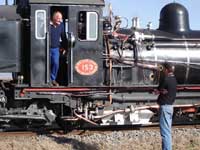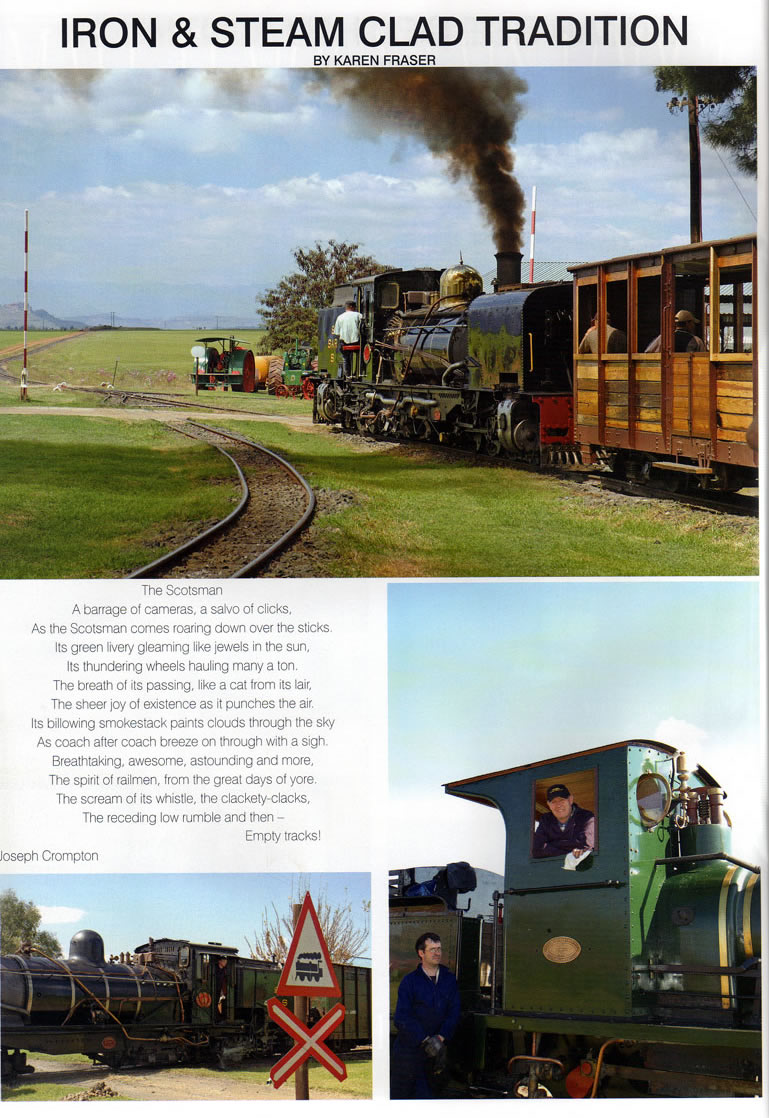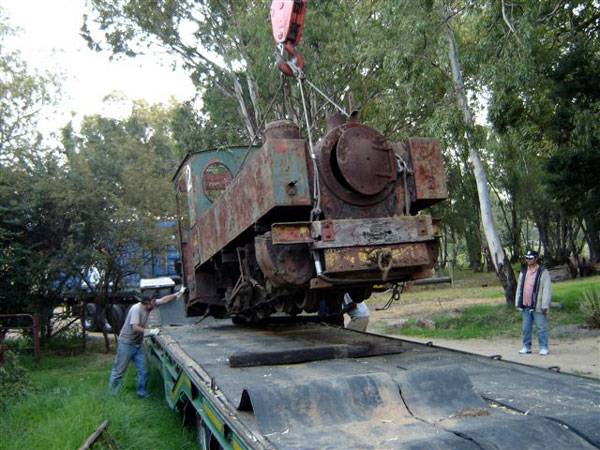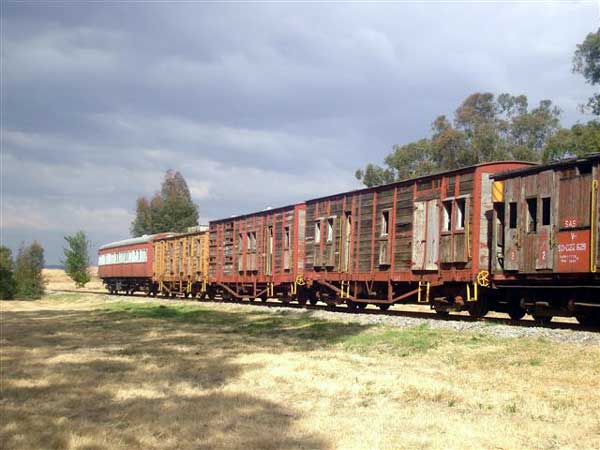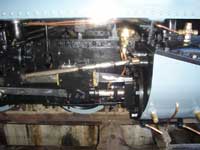|
|
|
SANDSTONE STEAM RAILWAY LOCOMOTIVE REPORT!
NGG 16 number 153:
This week the boiler washout plugs were fitted back and she was prepared for a very special visit from Rovos Rail on Friday. Derick also repaired the water leak in the bunker of 153 and it was then painted with a coat of rubberising paint to give protection to the plates.
Left: A photo from above looking into the empty coalbunker of 153
|
|
|
|
|
CLASS NG 15 number 17:
The tarot spindles of the Kalahari were also packed this week. A sharp thin prigger is used to remove the hard old rope packing in the confined space around the spindle. The Kalahari was also prepared for the visit of Rovos Rail.
Above right is a photo of the Kalahari’s tarot.
|
|
The Kalahari’s lead plugs were also removed. The old lead was fused out and re-used to lead them again. The repairs on the Kalahari’s brick arch were also done.
Left: A photo of Derick van Zyl in the Firebox of the Kalahari, removing the lead plugs.
Right: Derick fusing out the old lead.
|
|
|
|
|
Below: The process of cleaning, tinting and throwing of the lead plugs!
|
|
|
|
|
LITTLE BESS
This little Miss Bess also was prepared for the Rovos tour group on Friday. Washout plugs were fitted back and her little boiler was filled. The valve glands and piston packing were packed this week.
Left: Little Bess valve gland
Right: Little Bess Piston packing.
|
|
|
|
|
THE DOUGLAS LOCOMOTIVE
Henry finished the fitting of lagging plates around the boiler and is busy fixing the dome cover for this locomotive.
|
|
|
|
THE SANDSTONE STEAM RAILWAY WAGONS
THE RATANGA WAGON:
Ben fitted the four steel frames for the seats this week. He then started with the window frames of this wagon. Below are photos of this restoration: |
|
|
|
|
|
|
WAGONS:
All the wagons that were going to be used on the trains on Friday underwent an inspection on the put and all were vacuum brake tested. This wagons includes the following: New brake van, 1146, 922, 2926, 1136, 2834, 2032, 2901, 3197, 180, PE 52, PE 67 and the old brake van. The Hunslet diesel Locomotive was used early in this week to shunt all the consists ready for trains on Thursday and Friday.
Below are photos of heavy shunting operation in Hoekfontein Station to shunt the consists into the correct sequence. |
|
|
|
|
|
THE SANDSTONE RAILWAY LINE:
Oupa is making huge progress with the maintenance on the Railway line. He is such a trustworthy employee and is taking his new job very seriously. Within time, this Railway line will be in a perfect condition. He is almost finished with the tracks in Hoekfontein Station and will then proceed to Grootdraai. He is securing and oiling 1080 bolts every day. This includes T-bolts and Fishplate bolts in a distance of 150 metres as well as servicing the points within the distance he works. |
|
|
|
|
|
SIGNS AND DECALS:
A signboard was made for the “overhead” and the words “Have a Safe Day “ was stencilled on it. Below are some photos of the signboard progress this week. |
|
|
|
|
|
|
|
|
BELOW: A night photo of the signboards!
|
|
|
STATION NAME BOARDS!
The Hoekfontein Station name board was stencilled this week and was fitted to poles. This Name board will be planted in the Hoekfontein Station in next week. |
|
|
The Locomotive Shed floors also received a paint touch-up this week. The put was painted again as well as areas where there was no paint. The paving in front of the shed was painted with white PVA paint.
Below: Photos of this paint upgrading! |
|
|
|
|
|
THE ROVOS TOUR:
All the locomotives that were to be used were coaled this week and the pipes were cleaned with Brasso.
A rail inspection was done early on Thursday morning to inspect the line and all level crossings. Dave Richardson did the inspection. Below is a photo of Dave and Nikki Garnett on the Wickham Railcar daring a cold winter morning! |
|
|
|
|
While they were away, the locomotives were raising steam down at the shed. We were preparing for an afternoon train ride for the Rovos Rail Tour group. The Rovos train was running late and could not make it for this afternoon train ride to Grootdraai.
Left: All cleaned their locomotives while they were raising steam.
Right: Derrick filling the lubricator of the Kalahari.
|
|
|
|
Below left: Driver Pat Ackerman performing locomotive shunting in the Shed area with the Kalahari.
Below right: Driver Shaun Ackerman with Little Bess |
|
|
|
| Below: Driver Pat with the Lawley. |
|
|
We double head the Lawley and the Kalahari to Grootdraai and back on Thursday afternoon to test the locomotives while they were in steam.
Below: A photo of the Lawley and the NG 15 double headed standing at the water column in Hoekfontein Station just before they departed to Grootdraai with a mix train. |
|
|
|
Above: Driver Pat leaning out of the Lawley’s cab keeping a good eye on the tracks in front of his train.
We stopped in the section and took photos of this rare seen double heading of the Lawley and the Kalahari at the helm of the mix train. Below are some photos to share! |
|
|
|
THE MAGIC HOURS OF THE NIGHT:
Two o’clock on Friday morning we started to prepare the locomotives for the Rovos Rail tour. The night was very cold and dark, and not long after we lit the fires, the night became magic with Locomotives gleaming in the light with spooky white clouds of steam hanging above the silhouettes of these Giant machines. |
|
|
|
|
|
The NG 15 and NGG 16 number 153 departed from the shed just before 6 o’clock on Friday morning and was ready to haul their trains at sunrise.
Below: A photo of the Kalahari at the break of the new day! |
|
|
| Below: The Kalahari with Driver Pat departs from Hoekfontein to Grootdraai to accompany 153 with photo run pasts. |
|
|
|
While these two locomotives performed their daily duties, their little sister locomotives were waiting their turn in the Locomotive shed to act as background for the tour visit to the shed.
Below left: Little Bess and the O&K |
|
|
| At 13H00 the tour group headed back to Ficksburg Station where the luxurious Rovos passenger train awaits for departure, pulled by Rovos Rails superb Class 25NC number 3484. |
|
|
| The passenger coaches on this train are Royal class and travelling in them can only be a dream. |
|
|
| After refuelling the oil for the oil burner, the massive class 25Nc hooked up the train and departed for the last part of the steam hauled section to Bethlehem. |
|
|
|
From the Past!
|
|
|
| Two Class 15F locomotives, number 3026 and 2998 based in Virginia. This photo was taken in August 1990 and a shadow of the end was already hanging over these two giant locomotives, within a month after the photo was taken, they were both withdrawn from service and replaced with two Class 34 Diesel locomotives. These two locomotives were amongst the ones that did not make it and were cut up a month ago. |
| |
| PLANNING FOR NEXT WEEK |
1.) To sandblast two Dz wagons and to spray paint them
2.) To sandblast Douglas locomotive and to spray with paint filler.
3.) To finish all woodwork on the Ratanga wagon and to varnish wood.
4.) To washout the Lawley
5.) To move all loose items from Pandora salvage yard
6.) To stencil all Station name boards and to put them up in the stations
7.) Rail Plan A and start with Plan B ( Hoekfontein – Grootdraai.)
8.) Repairs on locomotives
9.) To clean all locomotives that was used.
10.) To shunt down B wagon for restoration.( 2968)
11.) To re-lead all spare lead plugs
12.) To fit sign boards
13.) To make km posts.
14.) To cut plates for Road decals and fit to poles.
15.) To wash out the O&K and prepare for B.I.
16.) To build Douglas locomotive cab.
17.) To sand wood for Douglas footplate. |
| |
|
STEAM GREETINGS... FROM THE STEAM TEAM!!!
|




















